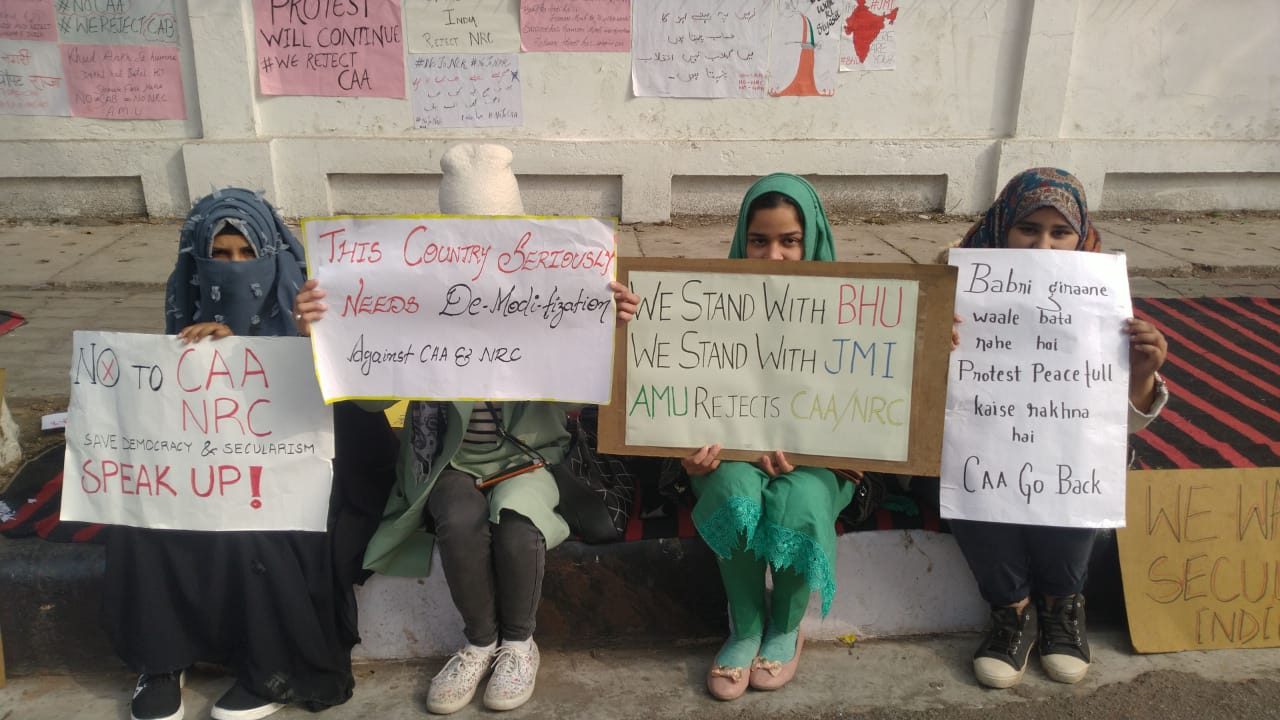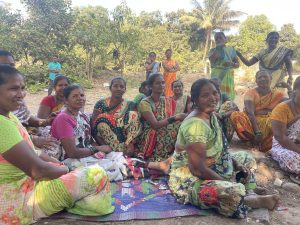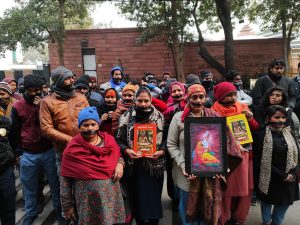“Women Of AMU Will Keep The Resistance Alive” Tazeen Junaid
Tazeen Junaid (18) believes she has a duty to keep the resistance against the discriminatory and exclusionary citizenship laws alive in Aligarh Muslim University.
On 15th December 2019, the Central Reserve Police Force entered AMU and cracked down on the students who were protesting against the police brutality against the students of Jamia Milia Islamia in India’s capital New Delhi. Following this, the university administration asked the resident students to vacate their hostels and the campus was closed.
In the aftermath of the police excesses, Tazeen and other non-resident women students gather every morning at 10 AM at Bab-e-Syed- the imposing main gate of AMU- to hold a peaceful vigil. They sing Taranas, read the preamble of the constitution of India and offer Namaaz until 4 PM as part of their protest.
The Government of India has legislated the Citizenship Amendment Act, 2019 which gives citizenship to persecuted minorities from neighbouring countries excluding Muslims. Additionally, it has announced the implementation of a National Register of Citizens, which demands documents of ancestry for future citizenship. Together these two instruments,as political scientist Professor Niraja Gopal Jayal explains, will lead to radical transformation and exclusion to India’s idea of citizenship.
Government of India’s citizenship laws have seen massive resistance across the country. Women across towns and cities in India have been leading these protests in the universities and outside of it. In the first part of documenting the role of women in the anti CAA and NRC resistance, we spoke with Saima Khan from Shaheen Bagh in New Delhi, where Muslim women have been leading a continuous sit-in for more than 20 days.
In this interview with BehanBox, Tazeen Junaid, a student of English literature at AMU and a first generation university goer from her family recounts the attacks on the students, trauma faced by the students, the stance of the university administration and how they are keeping up the momentum of the movement with the help of the local community in Aligarh.
How did the anti- CAA and NRC movement begin in Aligarh Muslim University?
AMU was the first campus in India to start a discussion and movement around the CAA and NRC. Not many people know about it.
It started right after the Ayodhya verdict. When the Supreme Court of India delivered the verdict on 9th November 2019, the AMU Student’s Collective, a core group of students in the university. held a discussion on it. In December, the Citizenship Amendment Bill (CAB) was being debated in the Parliament. Between the 9th and 14th December 2019, we organised public talks on CAB and NRC, where scholars and activists such as Dr.Kafeel Khan, Yogendra Yadav and many others spoke. We asked the AMU administration, the teaching and non-teaching faculty of the campus to join in the movement against these new citizenship laws. We organised a Maha-Mashaal march (torch rally). This is where the entire movement began. On 11th December, a day after the CAB was passed, 25,000 students of AMU went on a hunger strike.
How did the violence on the students of AMU start?
On the 15th December, when police entered and unleashed violence on the students of Jamia Milia Islamia University in Delhi, the students in AMU organised a solidarity march to Bab-E-Syed Marg. When we reached Bab-E-Syed, we found the gates to be locked. What we saw was that the CRPF was stationed and they refused to open the gates. They started abusing us with slurs like “Come out, motherfuckers!” tempers were already running high among angry students but we kept calm.
Soon, the Bab-E-Syed gate was cut open by elements that we were planted from outside. We know this because students do not know how to do it and it was a neatly done job. The CRPF started to use use tear gars and lathi charge us. CRPF then entered the campus with the permission of the AMU administration at 10 PM that night.
Was the university locked down right after this night of CRPF crackdown?
The CRPF entered the campus at 10 pm on the 15th of December, and kept beating the students up until 4 am. Following this, the administration put out a notice asking all students to vacate the hostels and the campus on the 17th of December. Students from Kashmir and Assam faced the greatest difficulty as both states are very vulnerable right now. When the Aligarh Muslim University Teachers Association (AMUTA) requested the Vice Chancellor (VC) to let the students who wanted to stay, remain in the hostels, he refused forthright. Basically, the students were thrown out.
In all this, the VC has been claiming in the media that it is not a forcible evacuation. But we have written notices contradicting his claims. We received a notice on the 1st January that the university will open after an indefinite period. It is a case of undeclared sine die right now.
What has happened to all the students, especially from Kashmir and Assam? Where have they gone?
The boys started fleeing at 4 am on 16th December, because the CRPF were entering the hostels and taking out the male students. Women students were also asked to go too. Kashmiri women wanted to stay and pleaded with the Administration as it is snowing in Kashmir and the roads are blocked. The administration arranged for buses up to Jammu and asked them to fend for themselves beyond that. That was their stance. For students from Assam, some of the faculty accompanied them till their homes.
I believe the students took out a notice expelling the registrar and the VC. Is that true?
Yes (laughs). It was the AMU students’ collective that issued a show cause notice to the VC, the teachers’ association and to the non-teaching association asking them if they were with us in this. We wrote that we were very saddened by what you did and we are expelling you from your position.
Show cause notice issued by the AMU students Collective to the Vice Chancellor of the university. (Photo Courtesy: Tazeen Junaid)
This is a very creative form of protest, one of the many we are seeing right now in the NRC resistance movement.
Yeah. It was about sending a message about the general sentiment of the students using the format which they use when they give us show-cause notices.
Have there been any fact-finding committees documenting what happened on the night of 15th December?
Yes, there have been two fact-finding reports. One was Harsh Mander who had a group of journalists with him and the other by the leaders of the previous Student Union of AMU.
The crackdown that happened was AMU a lot worse but it has not received adequate coverage. 26 students were detained and tortured. Also, five students have cases of Gunda Act registered against them. Other than that, there were 26 named reports and 1500 unnamed reports against students.
Among the students will be a lot of women like yourself- first generation university students- who come out to study after struggle with their families. What effect might this have on their future course of studies?
Yes, Absolutely. Parents, especially of women students are very scared after all the violence. They don’t want to trust the VC and the administration with their children, but they don’t have an option. There are a lot of families who send their girls to study, but they don’t give them complete independence. So for such students, coming back right now is very difficult
One of my own friends, who is part of the AMU students collective, comes from a very conservative family. Her family is very worried for her and she faces a lot of resistance from them.
Women students of Aligarh Muslim University protesting against the NRC and CAA. (Photo courtesy: Tazeen Junaid)
One of the remarkable things about the NRC and CAA resistance movement is the leadership women have assumed, especially Muslim women, whether in Shaheen Bagh, Seelampur, Hyderabad and even small towns like Malegaon. Tell me about the role of women such as yourself in AMU,both at the forefront and behind the scenes.
In the beginning there were 2 or 3 women students, mostly non resident local students who were involved in the organisation of the movement. This is mainly because women in the university cannot come out of their hostels after 5 PM, which is when we were able to organise the public talks. We were in charge of liaising with the media and documentation.
I study in the women’s college, which is very far from the main campus. On the 15th December, when the CRPF entered the campus, around 100-150 women students broke the gates of the Halls to join the protests. It is a big thing for girls to go from the hostels to the main campus. Women did it once before in 2018 to join the Jinnah protests. Right now, resident women students are not only fighting for the current cause but also fighting the administration of the hostels.
You have to remember that there is no students’ union in AMU right now. There is no students’ union in women’s college. So the girls went out on their individual responsibility.
After the crackdown, we knew that the boys can be lathi-charged at any time. There were fewer female constables and we knew that they would not be able to handle women if we came out to protest. After the hostels were vacated and male students went away, it was the local non- resident women students who came to Bab-E-Syed regularly since the 16th December. They sat at the Maulana Azad library and refused to leave. Now, women have become the face and the organisers of the protest.
What role did the local women of Aligarh play in sustaining the movement started by the students?
Women in Jamalpur, Chungi and Shehar area of the city played a huge part. When 26 students were detained by the police, women took out huge rallies condemning this. Every woman contributed. If there were two women in the household, one would protest for about 6 hours and come back, followed by the other who would take her place in the protest. They stood in protest for about 12 hours from noon to midnight. After that the students were released.
What has been the role of the general public in Aligarh after the attack on the students, and the lockdown as well as the anti-CAA and NRC movement?
They have been very supportive during the crackdown on AMU.They were giving us funds. But, after the crackdown, they realized their role more. Earlier, they were not very aware of the implications and intricacies of CAA-NRC. We planned to do an awareness and outreach campaign during our winter vacations. After they saw what happened to the students, they came out on the streets in support regularly.
A friend told me that as he left the hostel after crackdown, some elders from Jamalpur came and supported the male students and offered them help. They had tears in their eyes.They told the students to go home as their parents as their parents would worry.
“When you return to the university after it opens we will hand over the movement to you, and will preserve it meanwhile”, they told the students.
From that day onwards, about 1000-2000 would march in Jamalpur everyday. The Rapid Action Force (RAF) would come and request them to go back. They would go back and return again in an hour or so. The same people, in the same numbers. (laughs)
What is your parents’ reaction to this?
Oh my god! Abba and Amma were very scared on 15th December because I was in the campus till 9:30 as news was filtering out of the campus. I told them not to worry since we were confident that the police would not be deployed inside. But once the male students were getting beaten up, we realized that nothing could be done, women students dispersed too. After that day they told me to switch-off my phone as they were scared that it was being traced.
They are right to be scared and protective of me. But they also know that I am thick skinned and I will be up to something over the phone, so they let me go out. They know that I’m one of the organizers of the Bab-e-Syed sit-ins. They know there is no stopping me and have given up. But they are very supportive. They just want me to be safe.
Martyrs’ tree memorialised by the students of AMU in memory of the protestors who died during the NRC and CAA resistance.
What are the sit in protests like currently when the university is locked down? How are you carrying forward the momentum of the movement?
Right now, the administration is very consciously trying for us to make a mistake, so that they then have the opportunity to suppress the whole movement. So we have not blocked any road, we just go to the footpath and sit there.
We have created a Martyrs’ tree for all who died in the protests across the nation. We light candles there every day. We have occupied a footpath alongside the road, where we sit from 10 AM to 4 PM.
We sing taranas, chant slogans, do our Namaz there. We are trying to sustain the movement till the students come back. It’s only when the students come back that we can do more. If we actively combat the administration right now, it will be very destructive. We should know when to step back in a movement.
What is the trauma that young people are going through? How are you processing it? And are you seeking any help?
There is a lot of trauma. I was there when the force entered the university and attacked the students. A lot of boys were pelted with stones, attacked and had tear-gas canisters thrown at them. One student Tabez, who’s admitted at AIIMS right now, has had a lot of internal bleeding because he was hit twice on the same place on his body with tear-gas cans. When the police entered the campus, the students were standing still at a crossing, they did not move, despite seeing the police moving towards them, through the gates. The courage that the boys showed at that moment is very inspiring. But it is equally traumatic.
One student told me how he did not sleep for three days. He did not even see the event unfold and only heard the sounds from outside his room. Another student was beaten up at the guest house, detained and no medical aid given to him.There is a lot of trauma for students who were not at the forefront too.
But we have talked to Jawaharlal Nehru Medical College here and they have agreed to give regular psychological counselling for whatever happened at the movement. We did an online funding campaign and we are using that amount to help students who are stranded and facing trauma so that they can get whatever medical help they need.
But we will keep this movement alive. Inquilaab Zindabad!
We believe everyone deserves equal access to accurate news. Support from our readers enables us to keep our journalism open and free for everyone, all over the world.







